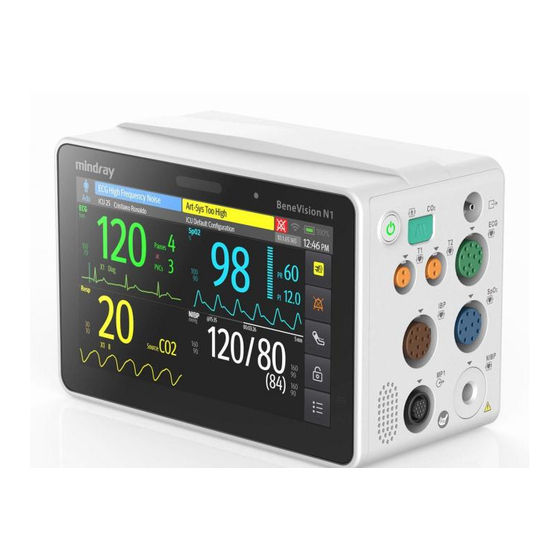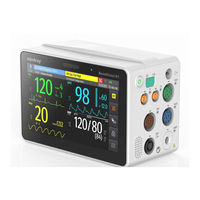
Mindray BeneVision N1 Patient Monitor Manuals
Manuals and User Guides for Mindray BeneVision N1 Patient Monitor. We have 3 Mindray BeneVision N1 Patient Monitor manuals available for free PDF download: Operator's Manual, Quick Reference Manual
Mindray BeneVision N1 Operator's Manual (306 pages)
Patient Monitor
Table of Contents
-
Safety
23 -
-
Main Unit28
-
Front View28
-
Left View29
-
Right View30
-
Bottom View30
-
-
Modular Rack30
-
Left View31
-
Right View31
-
-
Dock32
-
Left View32
-
Right View32
-
Rear View33
-
-
Installation34
-
-
-
Dialogs44
-
-
Module Mode46
-
Privacy Mode46
-
Night Mode47
-
Standby Mode47
-
Outdoor Mode48
-
-
Remote View60
-
-
Alarms
69-
CPB Mode78
-
-
ECG Display82
-
-
ECG Relearning101
-
-
-
Resp Display110
-
-
Spo Introduction115
-
Spo Display117
-
-
-
-
NIBP Display128
-
-
-
IBP Introduction135
-
IBP Display138
-
-
-
-
CO Introduction147
-
CO Display148
-
CO Calibration155
-
-
Review
157-
Review Overview157
-
Review Dialog157
-
-
- 1
167 -
-
-
Printing
183-
End Case Reports183
-
List of Reports187
-
-
Advertisement
Mindray BeneVision N1 Operator's Manual (285 pages)
Patient Monitor
Brand: Mindray
|
Category: Medical Equipment
|
Size: 5.89 MB
Table of Contents
-
Safety21
-
Warnings21
-
Cautions22
-
Notes22
-
Main Unit25
-
Front View25
-
Left View26
-
Right View27
-
Bottom View27
-
Modular Rack27
-
Left View28
-
Right View28
-
Dock28
-
Rear View30
-
Menus42
-
Module Mode45
-
Privacy Mode45
-
Night Mode46
-
Standby Mode47
-
Outdoor Mode47
-
Remote View67
-
Alarm Watch69
-
Mldap72
-
Alarms74
-
CPB Mode86
-
ECG Display90
-
ECG Relearning111
-
Calibrating ECG111
-
Resp Display118
-
Spo Introduction122
-
Spo Display124
-
Displaying SIQ127
-
NIBP Display134
-
NIBP Maintenance138
-
IBP Introduction139
-
Measuring ICP141
-
IBP Display142
-
Measuring PAWP146
-
CO Introduction149
-
CO Display151
-
Sensor155
-
CO Calibration160
-
Review162
-
Review Overview162
-
Review Page162
Mindray BeneVision N1 Quick Reference Manual (26 pages)
Brand: Mindray
|
Category: Medical Equipment
|
Size: 0.15 MB
Table of Contents
-
Gestures
7 -
Standby
9 -
Print
9 -
Ecg
11 -
Nibp
13 -
Alarms
17 -
Reset Alarms
19 -
Review
20 -
Volumes
21-
Alarm Volume21
-
Key Volume21
-
Beat Tone22
-
Advertisement


